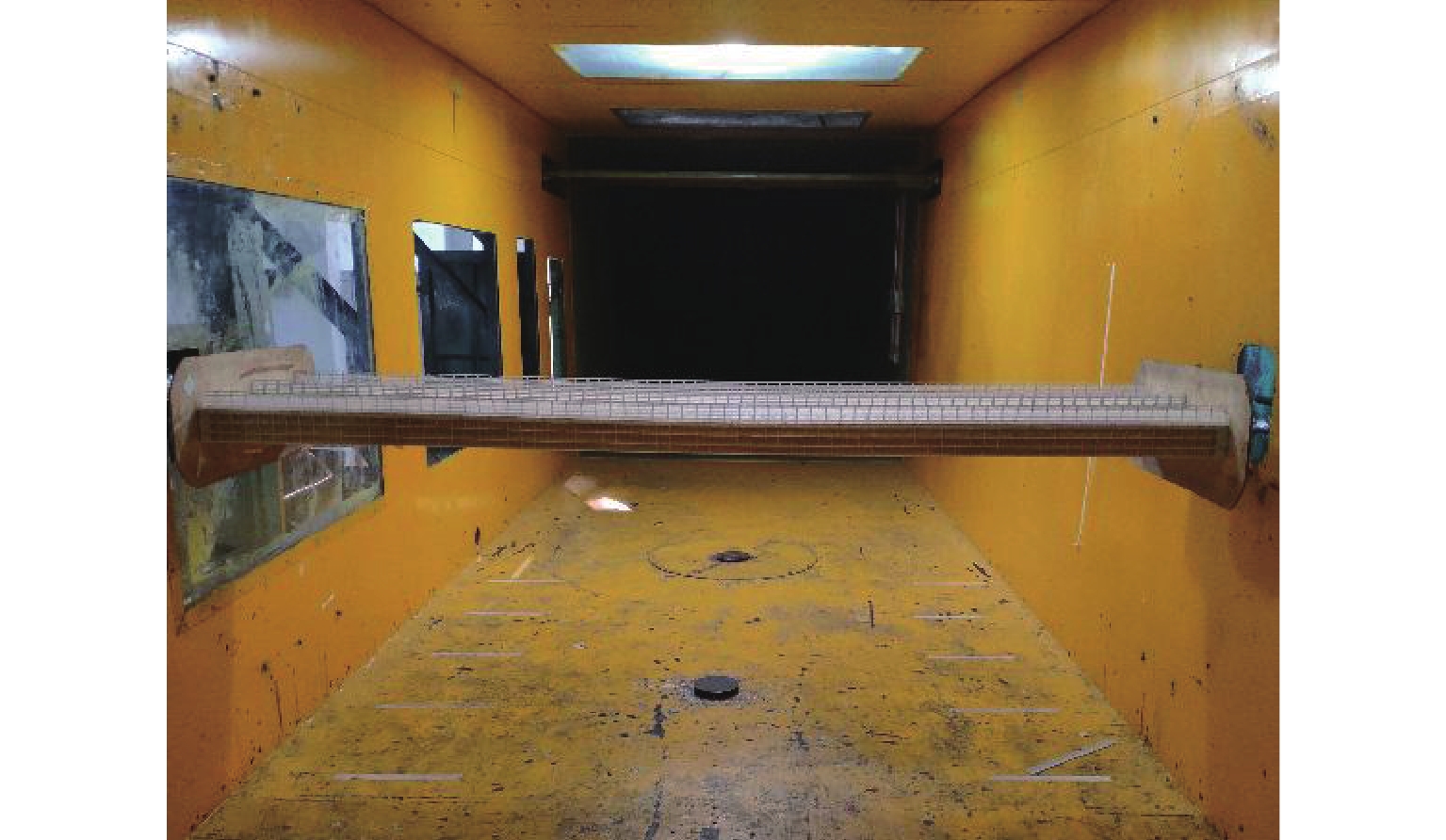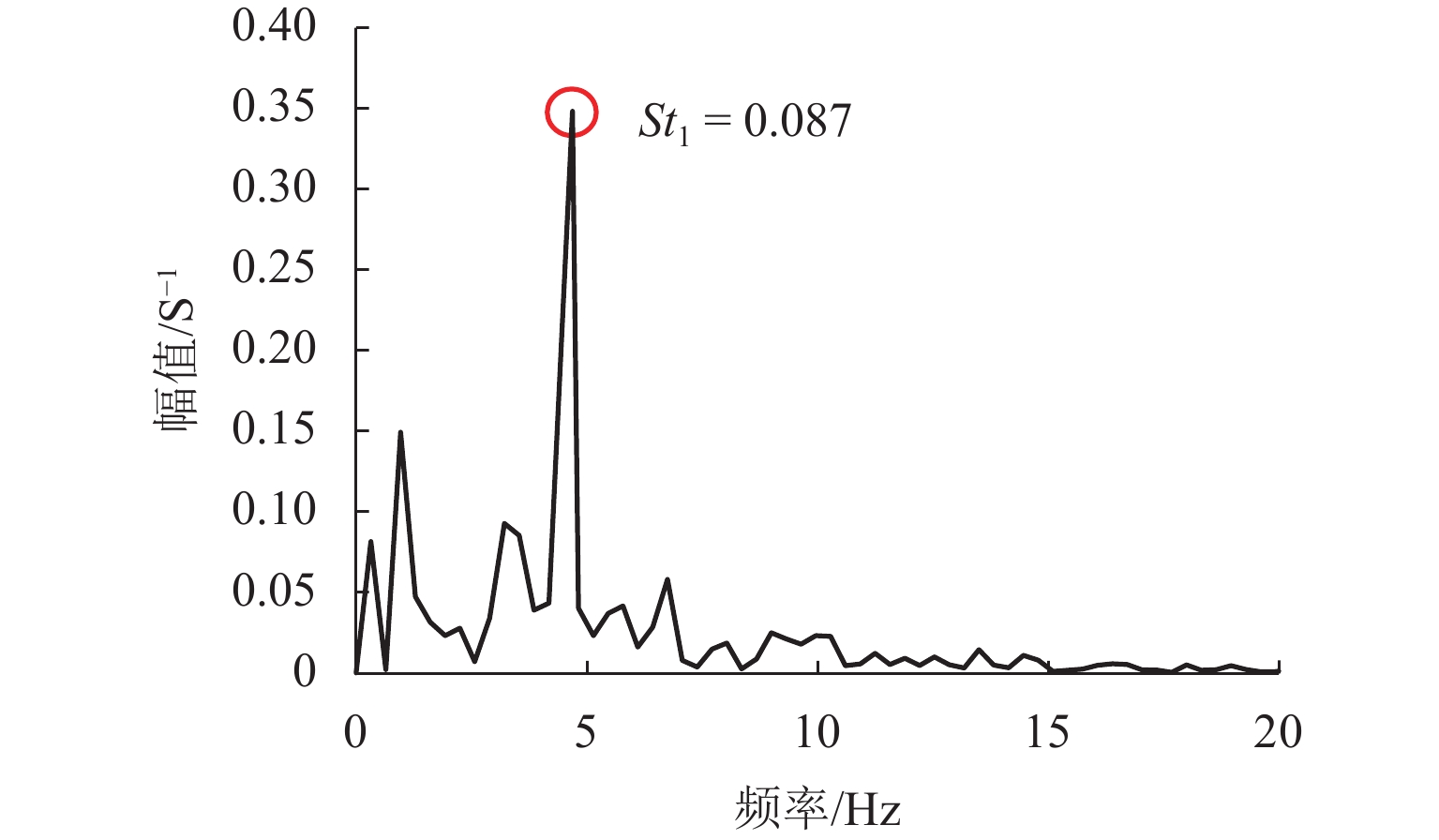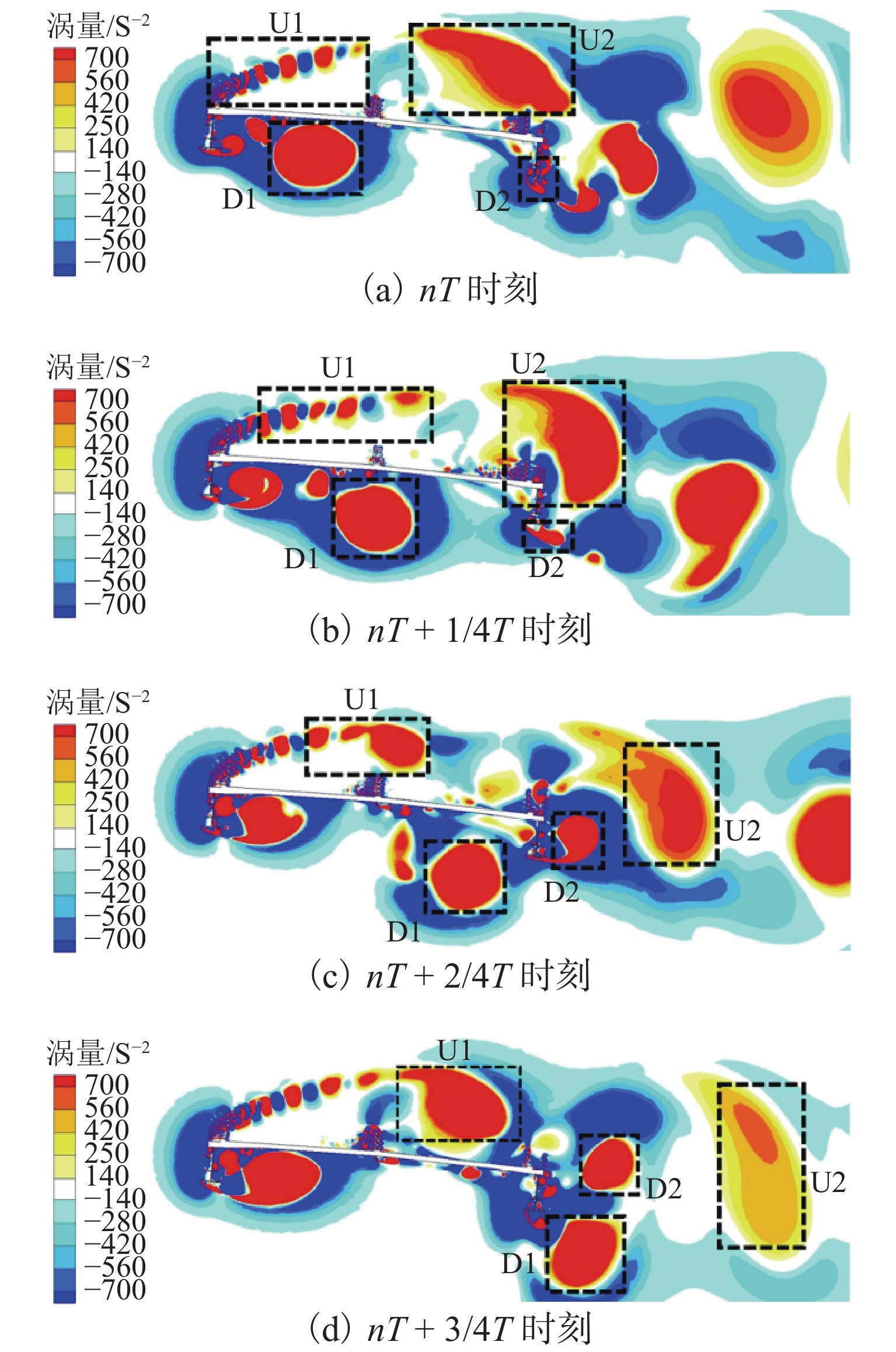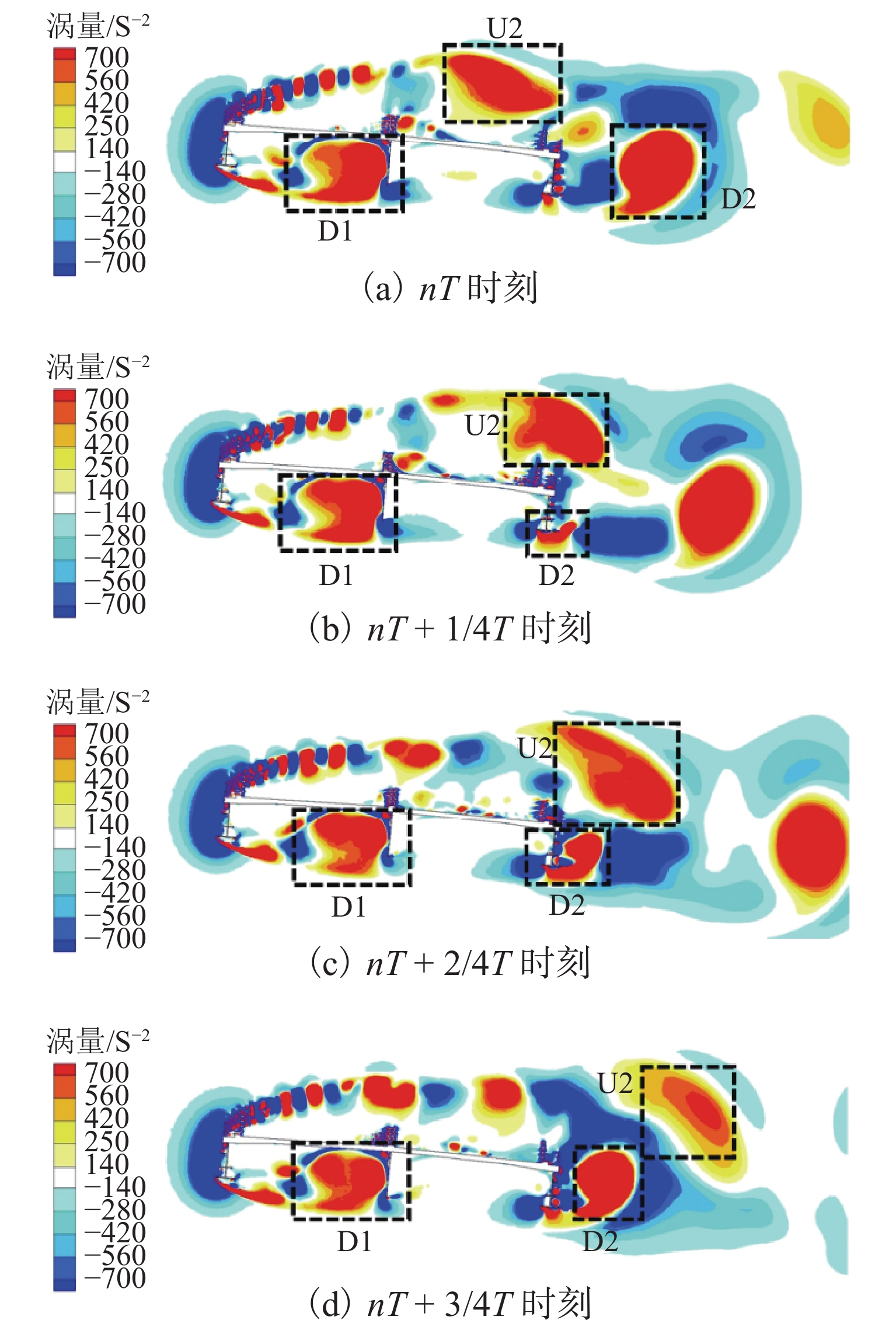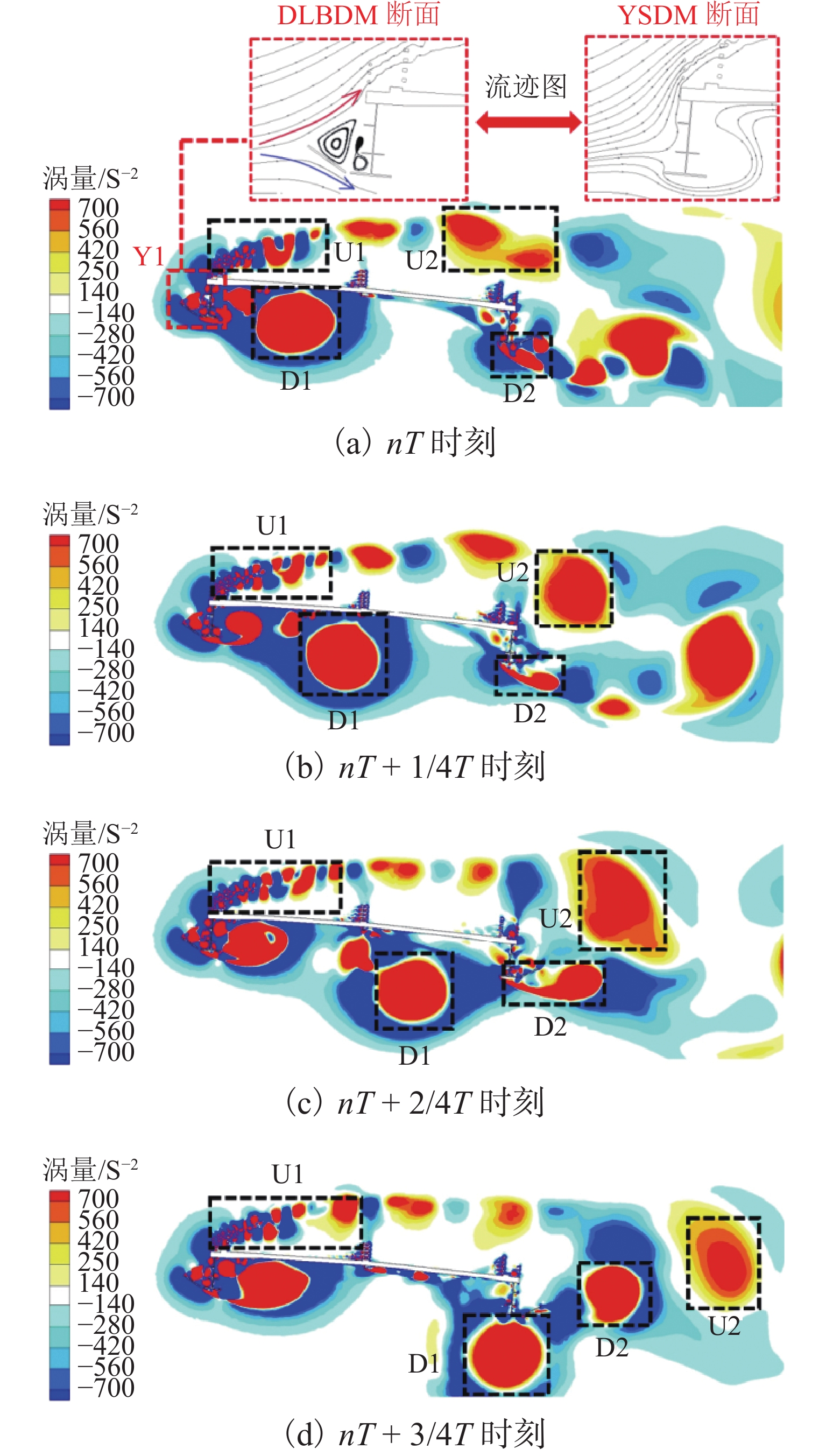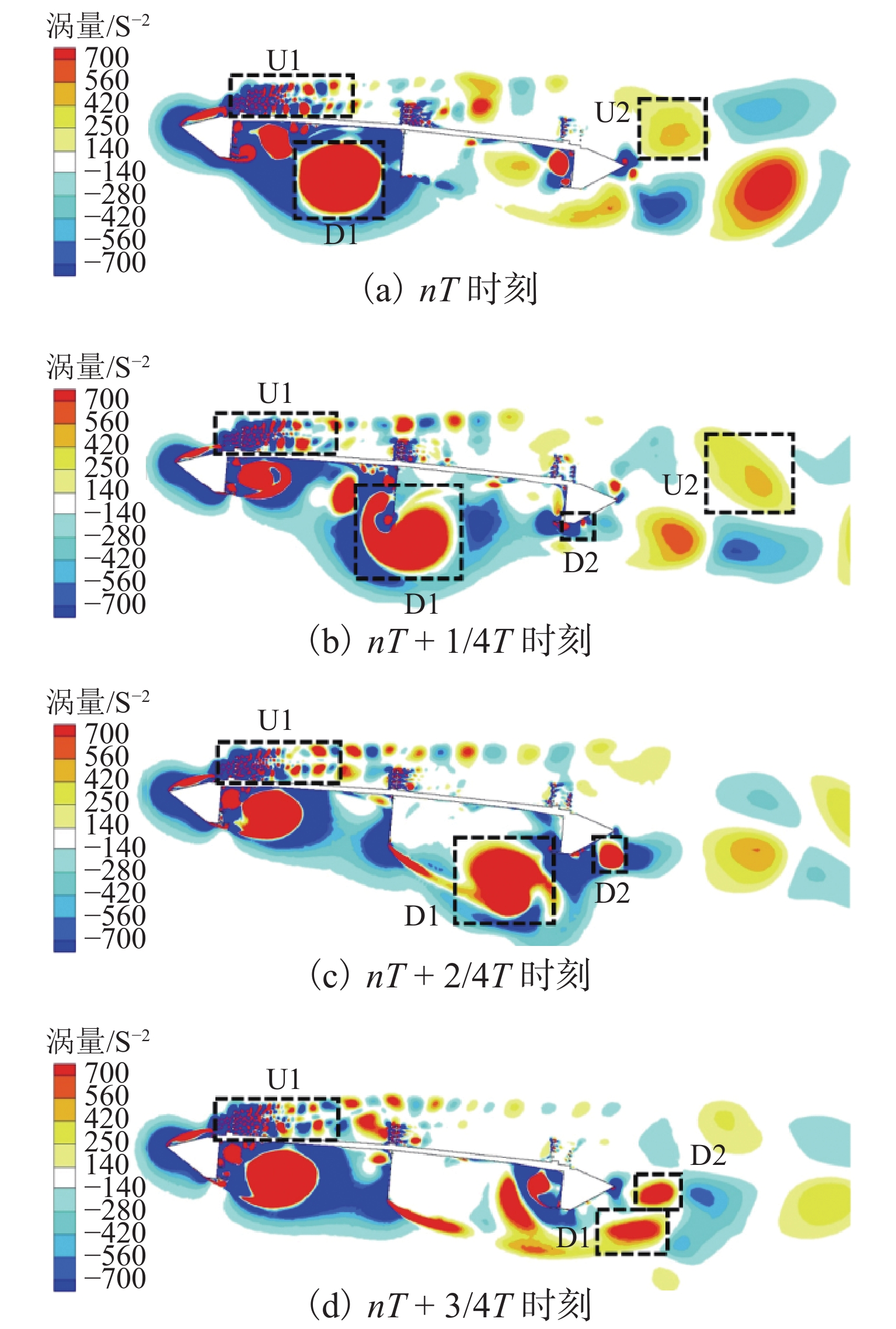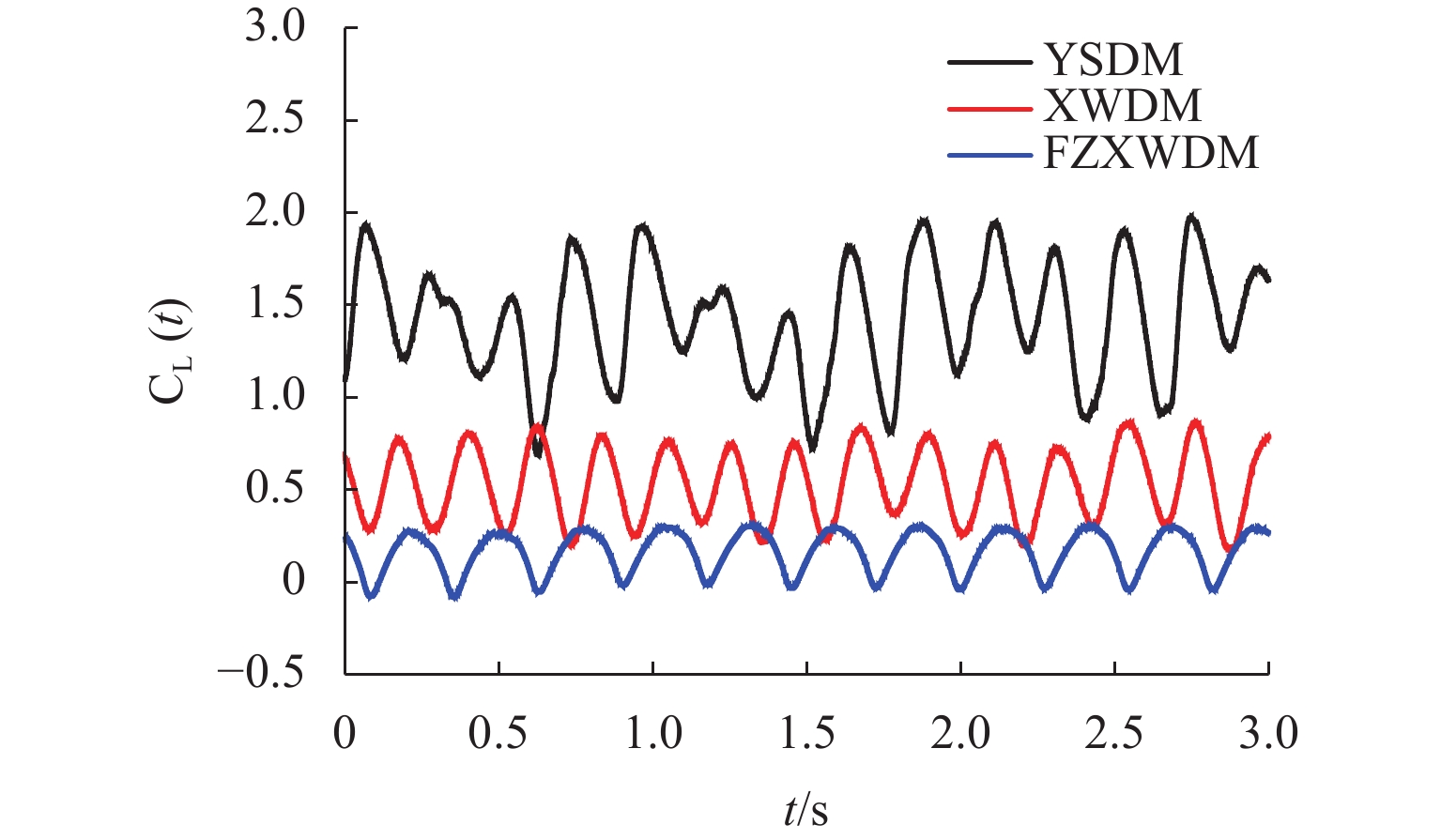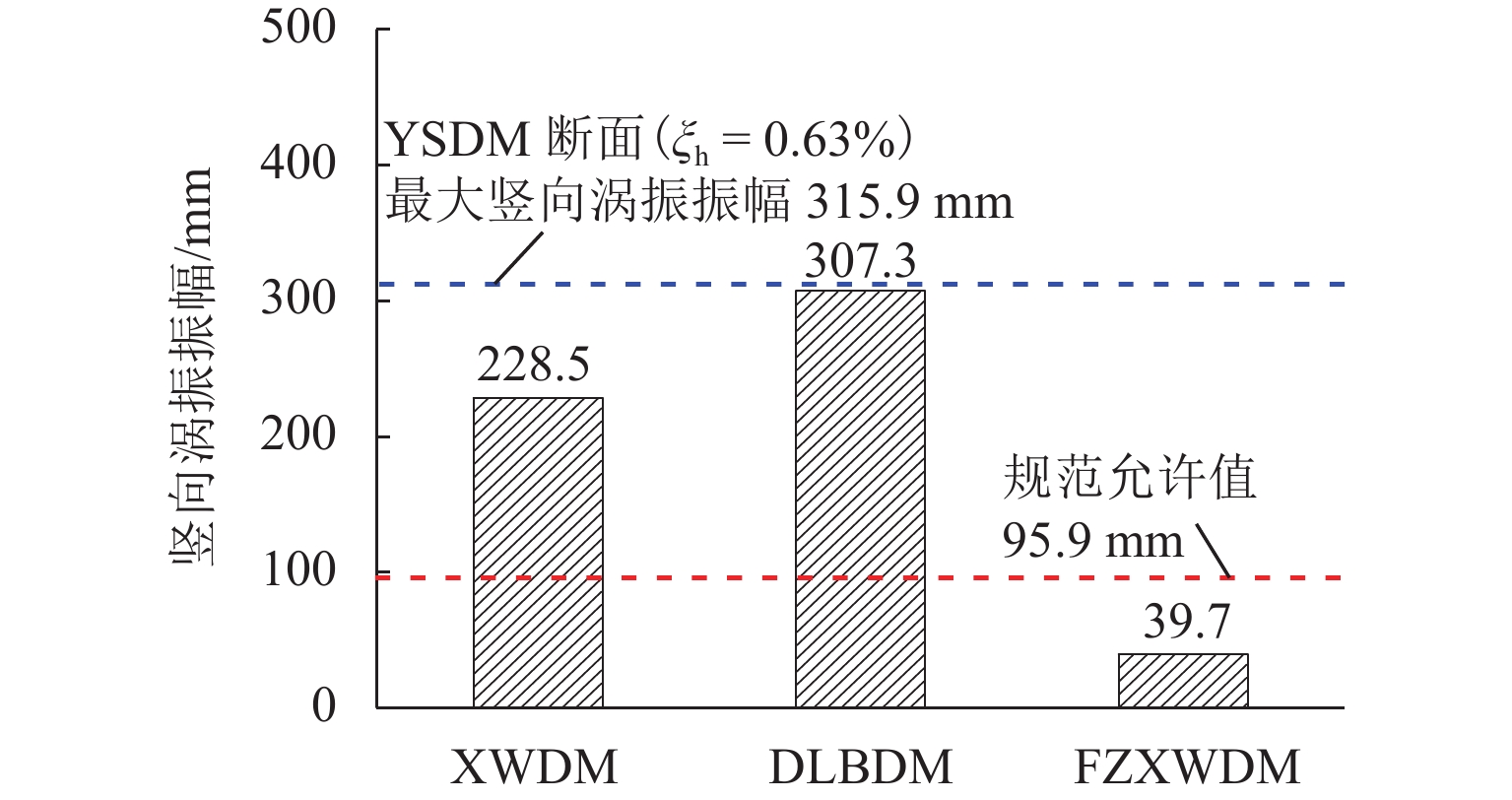Vortex-Induced Vibration (VIV) Aerodynamic Measures of Girder with Side Beam Based on Computation Fluid Dynamics (CFD) and Wind Tunnel Test
-
摘要:
为能够快捷且经济地完成开口类钝体桥梁断面涡振制振气动措施的选型,以一座边主梁叠合梁斜拉桥为背景,采用“CFD (computation fluid dynamics)数值模拟选型 + 风洞试验验证”的思路对其涡振制振气动措施选型进行研究. 该桥原设计主梁断面在常遇风速下存在显著涡激振动,为完成气动措施的初步选型,采用CFD数值计算对原设计断面的流场进行模拟,通过研究原设计断面的旋涡脱落状态确定主要旋涡抑制对象,进而有针对性地模拟了3种气动措施(下中央稳定板、导流板与风嘴)对主要脱落旋涡的抑制作用,通过将各断面旋涡脱落状态与三分力系数进行对比分析,得到各断面涡振性能的相对优劣关系,并最终选取风嘴与下中央稳定板结合而成的组合气动措施进行风洞验证试验. 试验结果表明:该组合气动措施能够有效抑制梁体在各风攻角下的涡激振动,且在 +5° 风攻角下,通过风洞试验得到的导流板、下中央稳定板、风嘴组合气动3种措施对原设计断面涡振振幅的减小作用依此递增,分别为2.7%、27.7%与87.4%,制振能力高低关系与数值模拟结果相一致;本次数值模拟结果符合预期要求,未来可针对不同类型桥梁断面进一步扩展数值模拟与风洞试验结果对比的数据集,以期更为准确、快捷地完成气动措施的选型.
Abstract:In order to quickly and economically select the vortex-induced vibration (VIV) aerodynamic suppression measures of the open-type bluff-body bridge section, a cable-stayed bridge of the composite girder with side beam was taken as the background, and the “CFD numerical simulation selection + wind tunnel verification test” was used to study the selection of VIV aerodynamic suppression measures. The original girder section has significant VIV under frequent wind speeds. In order to complete the selection of aerodynamic measures, the CFD numerical calculation was used to simulate the flow field of the original section. Through the research on the vortex shedding state of the original section, the main vortex suppression objects were determined. Then the three aerodynamic measures (lower central stabilizer, guide vane, and wind fairing) were simulated in a targeted way to suppress the main shedding vortexes. By comparing the vortex shedding state and the three-component force coefficient of each section, the relative advantages and disadvantages of the VIV performance of each section were obtained. Finally, the combined aerodynamic measures involving the wind fairing and the lower central stabilizer were selected for the wind tunnel verification test. The test results show that the combined aerodynamic measure can effectively suppress the VIV of the girder at various wind attack angles. At the wind attack angle of +5°, the reduction effect of three combined aerodynamic measures, namely, the guide vane, the lower central stabilizer, and the wind fairing, on the VIV amplitude of the original section obtained through the wind tunnel test increases accordingly, which is 2.7%, 27.7%, and 87.4% respectively. The relative relationship between the VIV suppression capacity of three aerodynamic measures obtained through wind tunnel tests is consistent with the numerical simulation results. The numerical simulation results meet the expected requirements, and the data set for comparing the numerical simulation and wind tunnel test results can be further expanded for different bridge sections in the future, so as to select aerodynamic measures more accurately and quickly.
-
表 1 主要模态参数
Table 1. Main modal parameters
振型 频率/Hz 等效质量/
(kg·m−1)等效质量惯性矩/
(kg·m2·m−1)一阶对称竖弯 0.42 30148 一阶反对称竖弯 0.55 44565 一阶对称扭转 0.79 3031103 一阶反对称扭转 1.19 2297427 表 2 节段模型试验参数
Table 2. Section model test parameters
参数名称 高度/m 宽度/m 单位长度
质量/(kg·m−1)单位长度质量
惯性矩/(kg·m2·m−1)竖弯
频率/Hz扭转
频率/Hz竖弯风速比 扭转风速比 实桥值 3.65 27 30148 3031103 0.42 0.79 缩尺比 1/50 1/50 1/502 1/504 8.34 7.55 模型值 0.07 0.54 12.06 0.49 2.50 5.20 表 3 计算断面说明
Table 3. Description of calculated section
断面编号 计算断面说明 YSDM 原设计断面 XWDM 设置 343 cm 下中央稳定板 DLBDM 设置 180 cm 倾斜角 30° 导流板 FZXWDM 设置 350 cm 风嘴、343 cm 下中央稳定板 表 4 不同网格数量计算结果
Table 4. Calculation results of different mesh numbers
网格规格 底层网格
厚度/mm网格数目/
(×104 个)St1 St2 误差/% Rough 0.05 21 0.081 0.094 13.8 Medium 0.03 38 0.087 0.094 7.4 Fine 0.01 59 0.089 0.094 5.3 -
[1] 聂建国. 钢-混凝土组合结构桥梁[M]. 北京: 人民交通出版社, 2011. [2] 李小珍,王聪,肖林,等. 斜拉桥钢-混凝土结合梁的受力性能试验研究[J]. 工程力学,2015,32(9): 191-199. doi: 10.6052/j.issn.1000-4750.2014.06.0550LI Xiaozhen, WANG Cong, XIAO Lin, et al. Test study for mechanical behavior of steel-concrete composite girder of cable-stayed bridge[J]. Engineering Mechanics, 2015, 32(9): 191-199. doi: 10.6052/j.issn.1000-4750.2014.06.0550 [3] OLIVEIRA PEDRO J J, REIS A J. Nonlinear analysis of composite steel-concrete cable-stayed bridges[J]. Engineering Structures, 2010, 32(9): 2702-2716. doi: 10.1016/j.engstruct.2010.04.041 [4] 钱国伟,曹丰产,葛耀君. Ⅱ型叠合梁斜拉桥涡振性能及气动控制措施研究[J]. 振动与冲击,2015,34(2): 176-181.QIAN Guowei, CAO Fengchan, GE Yaojun. Vortex-induced vibration performance of a cable-stayed bridge with Ⅱ shaped composite deck and its aerodynamic control measures[J]. Journal of Vibration and Shock, 2015, 34(2): 176-181. [5] 李欢,何旭辉,王汉封,等. π型断面超高斜拉桥涡振减振措施风洞试验研究[J]. 振动与冲击,2018,37(7): 62-68.LI Huan, HE Xuhui, WANG Hanfeng, et al. Wind tunnel tests for vortex-induced vibration control measures of a super high cable-stayed bridge with π-cross section[J]. Journal of Vibration and Shock, 2018, 37(7): 62-68. [6] 段青松,马存明. 半开口和分离边箱开口断面主梁竖向涡振性能对比[J]. 交通运输工程学报,2021,21(4): 130-138.DUAN Qingsong, MA Cunming. Comparison of vertical vortex-induced vibration characteristics between semi-open girder and separated edge-boxes open girder[J]. Journal of Traffic and Transportation Engineering, 2021, 21(4): 130-138. [7] KUBO Y, KIMURA K, SADASHIMA K, et al. Aerodynamic performance of improved shallow π shape bridge deck[J]. Journal of Wind Engineering and Industrial Aerodynamics, 2002, 90(12/13/14/15): 2113-2125. [8] 颜宇光,杨詠昕,周锐. 开口断面主梁斜拉桥的涡激共振控制试验研究[J]. 中国科技论文,2015,10(7): 760-764,787.YAN Yuguang, YANG Yongxin, ZHOU Rui. Experimental study on vortex induced vibration control measure for cable-stayed bridge with open sections[J]. China Sciencepaper, 2015, 10(7): 760-764,787. [9] 李春光,黄静文,张记,等. 边主梁叠合梁涡振性能气动优化措施风洞试验研究[J]. 振动与冲击,2018,37(17): 86-92.LI Chunguang, HUANG Jingwen, ZHANG Ji, et al. Aerodynamic optimization measures for VIV performances of a side girder composite beam based on wind tunnel tests[J]. Journal of Vibration and Shock, 2018, 37(17): 86-92. [10] 战庆亮,周志勇,葛耀君. 开口叠合梁断面气动性能的试验研究[J]. 桥梁建设,2017,47(1): 17-22.ZHAN Qingliang, ZHOU Zhiyong, GE Yaojun. Experimental study of aerodynamic performance of open cross sections of composite girders[J]. Bridge Construction, 2017, 47(1): 17-22. [11] 王嘉兴,牛华伟,靳俊中,等. 钢-砼叠合边主梁斜拉桥稳定板气动措施研究[J]. 振动与冲击,2017,36(8): 48-54.WANG Jiaxing, NIU Huawei, JIN Junzhong, et al. Study on stabilizer aerodynamic measure of a cable-stayed bridge with a steel-concrete composite edge girder[J]. Journal of Vibration and Shock, 2017, 36(8): 48-54. [12] 贺耀北,周洋,华旭刚. 双边钢主梁-UHPC组合梁涡振抑制气动措施风洞试验研究[J]. 振动与冲击,2020,39(20): 142-148.HE Yaobei, ZHOU Yang, HUA Xugang. A wind tunnel test on aerodynamic measures for vortex-induced vibration suppression of a bilateral steel-UHPC composite beam[J]. Journal of Vibration and Shock, 2020, 39(20): 142-148. [13] 张天翼,孙延国,李明水,等. 宽幅双箱叠合梁涡振性能及抑振措施试验研究[J]. 中国公路学报,2019,32(10): 107-114,168.ZHANG Tianyi, SUN Yanguo, LI Mingshui, et al. Experimental study on vortex-induced vibration performance and aerodynamic countermeasures for a wide-width double-box composite beam[J]. China Journal of Highway and Transport, 2019, 32(10): 107-114,168. [14] ZHANG T Y, SUN Y G, LI M S, et al. Experimental and numerical studies on the vortex-induced vibration of two-box edge girder for cable-stayed bridges[J]. Journal of Wind Engineering and Industrial Aerodynamics, 2020, 206: 104336.1-104336.12. [15] 王锋. 基于CFD对大跨度连续桥梁抗风性能分析[J]. 公路工程,2018,43(3): 83-86,167. doi: 10.3969/j.issn.1674-0610.2018.03.017WANG Feng. Analysis of wind resistance performance of long-span continuous bridges based on CFD method[J]. Highway Engineering, 2018, 43(3): 83-86,167. doi: 10.3969/j.issn.1674-0610.2018.03.017 [16] 张志田,张显雄,陈政清. 桥梁气动力CFD模拟中湍流模型的应用现状[J]. 工程力学,2016,33(6): 1-8.HANG Zhitian, ZHANG Xianxiong, CHEN Zhengqing. Status of the application of turbulence models in CFD simulations of bridge aerodynamc loads[J]. Engineering Mechanics, 2016, 33(6): 1-8. [17] MANNINI C, ŠODA A, VOß R, et al. Unsteady RANS simulations of flow around a bridge section[J]. Journal of Wind Engineering and Industrial Aerodynamics, 2010, 98(12): 742-753. doi: 10.1016/j.jweia.2010.06.010 [18] GE Y J, XIANG H F. Computational models and methods for aerodynamics flutter of long-span bridges[J]. Journal of Wind Engineering and Industrial Aerodynamics, 2008, 96(10): 1912-1924. [19] 同济大学. 公路桥梁抗风设计规范: JTG/T 3360-01—2018[S]. 北京: 人民交通出版社, 2018. [20] 李春光,毛禹,韩艳,等. 窄幅边主梁斜拉桥涡振性能及气动控制措施研究[J]. 铁道科学与工程学报,2022,19(5): 1347-1354.LI Chunguang, MAO Yu, HAN Yan, et al. Vortex induced vibration performance and aerodynamic control measures of cable stayed bridge with narrow side girder[J]. Journal of Railway Science and Engineering, 2022, 19(5): 1347-1354. [21] 刘君,廖海黎,万嘉伟,等. 检修车轨道导流板对流线型箱梁涡振的影响[J]. 西南交通大学学报,2015,50(5): 789-795.LIU Jun, LIAO Haili, WAN Jiawei, et al. Effect of guide vane beside maintenance rail on vortex-induced vibration of streamlined box girder[J]. Journal of Southwest Jiaotong University, 2015, 50(5): 789-795. [22] HALLAK P H, PFEIL M S, DE OLIVEIRA S R C, et al. Aerodynamic behavior analysis of Rio-Niterói bridge by means of computational fluid dynamics[J]. Engineering Structures, 2013, 56: 935-944. doi: 10.1016/j.engstruct.2013.06.010 [23] ZHU Z W, CHEN Z Q. Large eddy simulation of aerodynamics of a flat box girder on long-span bridges[J]. Procedia Engineering, 2013, 61: 212-219. doi: 10.1016/j.proeng.2013.08.006 [24] 欧阳克俭,陈政清. 中央稳定板提高颤振稳定性能的细观作用机理[J]. 振动与冲击,2016,35(1): 11-16. doi: 10.13465/j.cnki.jvs.2016.01.003OUYANG Kejian, CHEN Zhengqing. Micro-mechanism of a central stabilizer for improving a bridge’s flutter stability[J]. Journal of Vibration and Shock, 2016, 35(1): 11-16. doi: 10.13465/j.cnki.jvs.2016.01.003 [25] 张彦. 桥梁气动自激力的数值模拟研究[D]. 成都: 西南交通大学, 2009. -






 下载:
下载:
